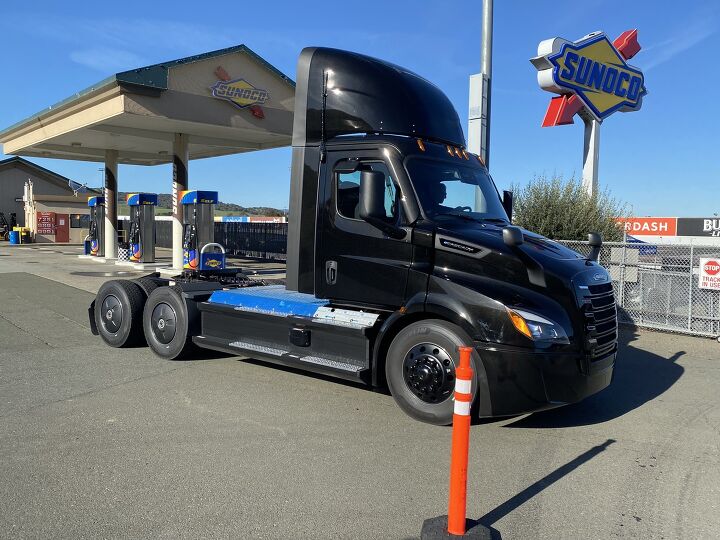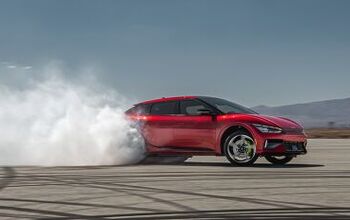Michelin's Sustainability Efforts Might Just Be, Well, Sustainable

If you’re interested in a career in automotive journalism, here’s a piece of unsolicited advice – don’t get in the passenger seat of a Lucid Air Sapphire with the car’s development engineer for hot laps of a major racetrack shortly after eating lunch.
If you do, you might find yourself burping unprofessionally as the driver slides through the esses.
Don’t get me wrong, it’s a lot of fun to ride shotgun with pro drivers when they’re going around a famed racetrack like Sonoma Raceway at speed. But normally I try to follow the same rule used for swimming – wait until 30 minutes after eating.
As fun as my ride in the Lucid was, it was a small part of a larger event put on by tire maker Michelin – one meant to give assembled media and analysts insight into the company’s sustainability plans. Other aspects of the event included a chance to chat fuel cells with Symbio, drive an electric-motor-powered big rig on the racetrack grounds, and a few laps of our own in new cars to get a sense of how Michelin’s newest rubber works. Well, two new cars – a Porsche Taycan and Mercedes-Benz EQS – and an aging Ford Explorer.
(Full disclosure: Michelin paid for my flight, hotel room, and meals so that I could attend the event.)
There was a lot going on last month at what was once called Sears Point. We spent our morning listening to key Michelin execs talk about sustainability when it comes to tires and other aspects of the business, and sat down with some of these same folks for interviews later. The rest of our day was given over to the events listed above.
Michelin president and CEO Alexis Garcin told us that the company is all about three P’s: People, profit, and planet. To that latter end, the company has a goal of having all its tires be made of 40 percent renewable and recycled materials by 2030, and 100 percent recycled/renewable by 2050.
If Michelin can achieve that, it claims that EVs shod with its tires will make up to 40 miles more range. When I pressed Michelin on if the company could hit its targets, Cyrille Roget, Michelin’s Scientific and Innovation Communication Director, said the company was “very confident” about 2030 but 2050 was more of an ambition. One challenge, he said, is to overcome negative consumer perceptions about recycled content.
Michelin also was happy to point out that its newest tires are already using 42 percent renewable/recycled materials. Fun fact, by the way – tires, whether they are sustainable or not, are made of 200 different materials.
Michelin won’t be selling sustainable tires solely to consumers – there will be fleet users, too. Pierluigi Cumo, VP of Michelin Business to Business Products for Michelin North America, told me improvements in mileage, rolling resistance, and how often the tires need to retreaded will be part of the sales story as Michelin works with fleets. That will be key, since demand has cratered recently after being unusually strong during the pandemic.
Roget also pointed out that consumers are more sensitive to retail price, while fleet customers care about lower rolling resistance and the fuel-economy savings that would follow.
You might be wondering why Michelin is making this push – is it in response to regulations? Roget says no, since regulators need to first define what constitutes “sustainable” before they can come up with regulations. Garcin also told us that OEMs are targeting a more sustainable tire for the cars and trucks they sell.
When it comes to sustainability, it’s not just about tires – Michelin is working on Wisamo, which is a sailing system for cargo ships.
This isn’t “The Truth About Cargo (Ships)”, however, so let’s take it back to cars and tires. We got the seat time in the EQS, Taycan, and Explorer to see how well this new rubber would help us stick to the pavement.
Obviously, each vehicle’s handling characteristics and abilities are impacted by more than just its tires. The Taycan was going to stick well no matter what rubber it was shod with, and the Explorer was similarly going to be a handful. Without a back-to-back comparison, it was hard to definitively state these Michelins were improved over tires that aren’t so sustainable, but they were definitely sticky enough for a few laps of track duty at 6- to 7-tenths effort. Even in the Explorer.
The Daimler Freightliner eCascadia I drove was shod with Michelin XLEZ+ tires, but tooling around at 10 mph on racetrack access roads isn’t much of a test – I simply had fun living out a childhood dream.
By the way, the Lucid mentioned above wore Michelin Pilot Sport 4 S rubber.
Sometimes the word “sustainable” conjures up an image of compromise. While our tire test gave us only a small taste of what these tires could do, it certainly seems that performance will not be sacrificed for sustainability, at least not with these Michelin tires. We’ll reserve more judgment until we can do a more comprehensive test, but if what we experienced is representative, those who want sustainability without loss of performance may be able to have their cake and eat it, too.
[Images © 2024 Tim Healey/TTAC.com, Michelin]
Become a TTAC insider. Get the latest news, features, TTAC takes, and everything else that gets to the truth about cars first by subscribing to our newsletter.

Tim Healey grew up around the auto-parts business and has always had a love for cars — his parents joke his first word was “‘Vette”. Despite this, he wanted to pursue a career in sports writing but he ended up falling semi-accidentally into the automotive-journalism industry, first at Consumer Guide Automotive and later at Web2Carz.com. He also worked as an industry analyst at Mintel Group and freelanced for About.com, CarFax, Vehix.com, High Gear Media, Torque News, FutureCar.com, Cars.com, among others, and of course Vertical Scope sites such as AutoGuide.com, Off-Road.com, and HybridCars.com. He’s an urbanite and as such, doesn’t need a daily driver, but if he had one, it would be compact, sporty, and have a manual transmission.
More by Tim Healey
Latest Car Reviews
Read moreLatest Product Reviews
Read moreRecent Comments
- Varezhka I have still yet to see a Malibu on the road that didn't have a rental sticker. So yeah, GM probably lost money on every one they sold but kept it to boost their CAFE numbers.I'm personally happy that I no longer have to dread being "upgraded" to a Maxima or a Malibu anymore. And thankfully Altima is also on its way out.
- Tassos Under incompetent, affirmative action hire Mary Barra, GM has been shooting itself in the foot on a daily basis.Whether the Malibu cancellation has been one of these shootings is NOT obvious at all.GM should be run as a PROFITABLE BUSINESS and NOT as an outfit that satisfies everybody and his mother in law's pet preferences.IF the Malibu was UNPROFITABLE, it SHOULD be canceled.More generally, if its SEGMENT is Unprofitable, and HALF the makers cancel their midsize sedans, not only will it lead to the SURVIVAL OF THE FITTEST ones, but the survivors will obviously be more profitable if the LOSERS were kept being produced and the SMALL PIE of midsize sedans would yield slim pickings for every participant.SO NO, I APPROVE of the demise of the unprofitable Malibu, and hope Nissan does the same to the Altima, Hyundai with the SOnata, Mazda with the Mazda 6, and as many others as it takes to make the REMAINING players, like the Excellent, sporty Accord and the Bulletproof Reliable, cheap to maintain CAMRY, more profitable and affordable.
- GregLocock Car companies can only really sell cars that people who are new car buyers will pay a profitable price for. As it turns out fewer and fewer new car buyers want sedans. Large sedans can be nice to drive, certainly, but the number of new car buyers (the only ones that matter in this discussion) are prepared to sacrifice steering and handling for more obvious things like passenger and cargo space, or even some attempt at off roading. We know US new car buyers don't really care about handling because they fell for FWD in large cars.
- Slavuta Why is everybody sweating? Like sedans? - go buy one. Better - 2. Let CRV/RAV rust on the dealer lot. I have 3 sedans on the driveway. My neighbor - 2. Neighbors on each of our other side - 8 SUVs.
- Theflyersfan With sedans, especially, I wonder how many of those sales are to rental fleets. With the exception of the Civic and Accord, there are still rows of sedans mixed in with the RAV4s at every airport rental lot. I doubt the breakdown in sales is publicly published, so who knows... GM isn't out of the sedan business - Cadillac exists and I can't believe I'm typing this but they are actually decent - and I think they are making a huge mistake, especially if there's an extended oil price hike (cough...Iran...cough) and people want smaller and hybrids. But if one is only tied to the quarterly shareholder reports and not trends and the big picture, bad decisions like this get made.








































Comments
Join the conversation
Funny referencing cake in your closing paragraph. The last time someone talked to the French people about eating cake, the results were mixed.
Michelin's price increases mean that my relationship with them as a customer is not sustainable. 🙁